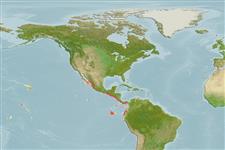Environment: milieu / climate zone / depth range / distribution range
Ecologie
marien benthopelagisch; diepte ? - 650 m (Ref. 34024), usually 40 - 75 m (Ref. 36413). Tropical; 25°N - 6°S
Eastern Central Pacific: Gulf of California to Peru.
Lengte bij maturiteit / Grootte / Gewicht / Leeftijd
Maturity: Lm 75.4 range ? - ? cm
Max length : 115 cm TL mannelijk / geslacht onbekend; (Ref. 55763); common length : 45.0 cm TL mannelijk / geslacht onbekend; (Ref. 55763)
Korte beschrijving
Morfologie | Morfometrie
Dorsale stekels (totaal): 0; Dorsale zachte stralen (totaal): 108-118; Anale stekels 0; Anale zachte stralen: 78 - 89; Wervels: 55 - 56. Body completely covered with small, imbricate, cycloid scales; barbels present on snout (6) and chin (6); branchiostegal rays 8; median basibranchial tooth patch absent; developed gill rakers on first arch 4 or fewer; pelvic fin rays inserted at about level of preopercle, well behind eye (Ref. 34024).
Adults benthopelagic to 650 m depth, juveniles common on reefs (Ref. 34024). At depths of about 40-75 m, adults are found deep on mud and broken shell bottom (Ref. 36413). Smaller silvery specimens taken far out at sea in the epipelagic (Ref. 34024). Caught occasionally (Ref. 34024). Oviparous, with late post-flexion and transformation stage larvae found in midwater (Ref. 36413). Oval, pelagic eggs float in a gelatinous mass (Ref. 205).
Oviparous, with no specialized copulatory organ (Ref. 36413).
Nielsen, J.G., D.M. Cohen, D.F. Markle and C.R. Robins, 1999. Ophidiiform fishes of the world (Order Ophidiiformes). An annotated and illustrated catalogue of pearlfishes, cusk-eels, brotulas and other ophidiiform fishes known to date. FAO Fish. Synop. 125(18):178p. Rome: FAO. (Ref. 34024)
Status op de Rode Lijst van het IUCN (Ref. 130435)
Gevaar voor de mens
Harmless
Gebruik door de mens
Visserij: van minder commercieel belang
Meer informatie
ReferentiesAquacultuurAquacultuurprofielKweeklijnenGeneticaElectrophoresesErfelijkheidZiektesVerwerkingNutrientsMassaconversie
Tools
Speciale rapporten
Download XML
Internetbronnen
Estimates based on models
Preferred temperature (Ref.
123201): 16 - 25.2, mean 19.4 °C (based on 24 cells).
Fylogenetische diversiteitsindex (Ref.
82804): PD
50 = 0.5156 [Uniqueness, from 0.5 = low to 2.0 = high].
Bayesian length-weight: a=0.00380 (0.00200 - 0.00722), b=3.12 (2.94 - 3.30), in cm total length, based on LWR estimates for this species & (Sub)family-body (Ref.
93245).
Trofisch niveau (Ref.
69278): 4.1 ±0.77 se; based on food items.
Weerstandsvermogen (Ref.
120179): Gemiddeld, minimale populatieverdubbelingstijd 1,4-4,4 jaar (Preliminary K or Fecundity.).
Prior r = 0.38, 95% CL = 0.25 - 0.57, Based on 1 stock assessment.
Fishing Vulnerability (Ref.
59153): Moderate to high vulnerability (45 of 100).
Nutrients (Ref.
124155): Calcium = 56.5 [31.2, 137.3] mg/100g; Iron = 0.759 [0.396, 1.366] mg/100g; Protein = 16.2 [13.7, 18.7] %; Omega3 = 0.202 [0.105, 0.413] g/100g; Selenium = 151 [68, 350] μg/100g; VitaminA = 11.9 [3.5, 39.7] μg/100g; Zinc = 0.728 [0.481, 1.126] mg/100g (wet weight);
